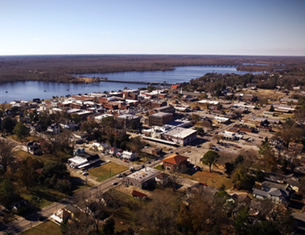The Supreme Court Rules On The Most Significant Second Amendment Case: NY State Rifle & Pistol Association v. Bruen
Mark Levin has called the most recent Supreme Court ruling on the meaning and intent of the Second Amendment
"the most significant Second Amendment case since Heller and McDonald." (landmark Second Amendment cases, 2008 and 2010, respectively). And I believe he is correct.
The state of New York makes it a crime to possess a firearm without a license, whether for inside or outside the home. An individual who wants to carry a firearm outside his or her home may obtain an
"unrestricted" license to
"have and carry" a concealed pistol or revolver IF he/she can prove that
"proper cause exists" for doing so. An applicant satisfies the
"proper cause" requirement ONLY IF he/she can
"demonstrate a special need for self-protection distinguishable from that of the general community."
There is no NY statute that adequately defines what constitutes
"proper cause." Consequently, the term is considered constitutionally
"vague."
In NY, a license applicant who wants to possess a firearm at home (or at a place of business) for self-defense must convince a
"licensing officer" (usually a judge or law-enforcement officer) that, among other things, he is: (1) of good moral character; (2) has no history of crime or mental illness, and (3) that there exists no good cause for the denial of the license. To obtain a firearm license to carry outside the home for self-defense, the applicant must obtain an unrestricted license to
"have and carry a concealed pistol or revolver." If the applicant cannot make such a showing that
"proper cause exists" to issue such a concealed carry license, he can only receive a
"restricted" license for public carry, such as for hunting, target shooting, or employment.
NY requires evidence of a
"special need" for self-protection outside the home. This special need standard is demanding and can rarely be met. NY courts generally require evidence of
"particular threats to life and safety, attacks, or other extraordinary danger to personal safety."
Petitioners Brandon Koch and Robert Nash, who are adult, law-abiding NY residents, were denied such an unrestricted license to carry a firearm in public on the basis that they failed to satisfy the
"proper cause" requirement. They, in turn, sued state officials for a violation of their Second and Fourteenth Amendment rights to bear arms in public for self-protection by being required to show
"a unique need for self-defense."
In a ruling handed down today, written by Justice Clarence Thomas, the US Supreme Court held that New York's
"proper cause" requirement, in fact, violates an individual's Second and Fourteenth Amendment rights. In a 6-3 opinion, the Court held that NY's law prevents law-abiding citizens with ordinary self-defense needs from exercising their Second Amendment right to keep and bear arms in public for self-defense.
Not only did the Court re-affirm the essential and critical meaning of the Second Amendment (the right to keep and bear arms for self-protection and self-defense) and affirm that the right is not a secondary right but an essential right, but it also rejected a
"2-step framework" (or test) that federal courts have instituted for analyzing Second Amendment challenges.
In order to determine whether a firearm regulation is consistent with the meaning and spirit (intent) of the Second Amendment, both the Heller and McDonald cases point to at least two relevant metrics:
(1) whether modern and historical regulations impose a comparable burden on the right of armed self-defense, and (2) whether the regulatory burden is comparably justified."
The test or framework from District of Columbia v. Heller (2008) and from McDonald v. Chicago (2010) is actually a simple one; it's primarily a textual and history test. The test demands that there be a connection rooted in the text and history of the Second Amendment (which goes back to the 1600's of England and to our American colonial times). The federal courts of appeal, however, have added a second step to the framework for Second Amendment challenges. They have added an
"ends versus means" type of scrutiny or analysis. That is, the courts have included an analysis that would justify the means (the burden to one's right to keep and bear arms) to the ends. In this case, by this opinion, the Supreme Court has outwardly rejected this second prong and announced that only the history and contextual prong of the test is necessary. The other prong violates and burdens an individual's Second Amendment right, according to the Court.
"We concluded that a constitutional guarantee subject to future judges' assessments of its usefulness is no constitutional guarantee at all."
"Despite the popularity of this two-step approach, it is one step too many. Step one of the predominant framework is broadly consistent with Heller, which demands a test rooted in the Second Amendment's text, as informed by history. But Heller and McDonald do not support applying a "means-vs- end" analysis in the Second Amendment context. Instead, the government must affirmatively prove that its firearms regulation is part of the historical tradition that delimits the outer bounds of the right to keep and bear arms."
"We reiterate that the standard for applying the Second Amendment is as follows: When the Second Amendment's plain text covers an individual's conduct, the Constitution presumptively protects that conduct. The government must then justify its regulation by demonstrating that it is consistent with the Nation's historical tradition of firearm regulation. Only then may a court conclude that the individual's conduct falls outside the Second Amendment's 'unqualified command.'"
And so, it is with this new clarification of a Second Amendment test that the Supreme Court analyzed NY's
"proper cause" requirement in order to receive an unrestricted conceal-carry license to carry a firearm.
"The Heller case exemplifies this kind of straightforward historical inquiry. One of the District of Columbia's regulations challenged 'totally banned handgun possession in the home.' The District addressed a perceived societal problem - firearm violence in densely populated communities, and it employed a regulation which was an outright ban on the possession of handguns in the home. Would the Founding Fathers have considered such an outright ban? After considering founding-era historical precedent," including
"various restrictive laws in the colonial period," and finding that none was analogous to the District's ban, the Court concluded that the handgun ban was unconstitutional.
New York's 'proper-cause' requirement concerns the same alleged societal problem addressed in Heller - handgun violence, primarily in urban areas."
In concluding his opinion, Justice Thomas wrote:
It is undisputed that petitioners Koch and Nash - two ordinary, law-abiding, adult citizens - are part of 'the people' whom the Second Amendment protects. Nor does any party dispute that handguns are weapons 'in common use' today for self-defense. We therefore turn to whether the plain text of the Second Amendment protects Koch's and Nash's proposed course of conduct-carrying handguns publicly for self-defense. We have little difficulty concluding that it does. Nothing in the Second Amendment's text draws a home/public distinction with respect to the right to keep and bear arms. As we explained in Heller, the 'textual elements' of the Second Amendment's operative clause - 'the right of the people to keep and bear Arms, shall not be infringed'- guarantees the individual right to possess and carry weapons in case of confrontation. Heller further confirmed that the right to 'bear arms' refers to the right to 'wear, bear, or carry . . . upon the person or in the clothing or in a pocket, for the purpose . . . of being armed and ready for offensive or defensive action in a case of conflict with another person.' This definition of 'bear' naturally encompasses public carry. Most gun owners do not wear a holstered pistol at their hip in their bedroom or while sitting at the dinner table. Although individuals often keep firearms in their home, at the ready for self-defense, most do not 'bear' them in the home beyond moments of actual confrontation. To confine the right to bear arms to the home would nullify half of the Second Amendment's operative protections. Moreover, confining the right to bear arms to the home would make little sense given that self-defense is the central component of the Second Amendment] right itself. [See Heller and McDonald]
After all, the Second Amendment guarantees an individual right to possess and carry weapons in case of confrontation and confrontation can surely take place outside the home. Although we remarked in Heller that the need for armed self-defense is perhaps "most acute" in the home, we did not suggest that the need was insignificant elsewhere. Many Americans hazard greater danger outside the home than in it. For example, an individual in Chicago is a good deal more likely to be attacked on a sidewalk in a rough neighborhood than in his apartment on the 35th floor of the Park Tower. The text of the Second Amendment reflects that reality. The Second Amendment's plain text thus presumptively guarantees petitioners Koch and Nash a right to 'bear' arms in public for self-defense.
Conceding that the Second Amendment guarantees a general right to public carry, respondents instead claim that the Amendment "permits a State to condition handgun carrying in areas 'frequented by the general public' on a showing of a nonspeculative need for armed self-defense in those areas," that claim, the burden falls on respondents to show that New York's proper-cause requirement is consistent with this Nation's historical tradition of firearm regulation. Only if respondents carry that burden can they show that the pre-existing right codified in the Second Amendment, and made applicable to the States through the Fourteenth, does not protect petitioners' proposed course of conduct. (Respondents could not make such a showing).
Before offering the Crown to William and Mary, the British Parliament wrote the predecessor to our Second Amendment into the 1689 English Bill of Rights, guaranteeing that 'Protestants . . . may have Arms for their Defence suitable to their Conditions, and as allowed by Law.' Although this right was initially limited (being restricted to Protestants and held only against the Crown, but not Parliament), it represented a watershed in English history. Englishmen had never before claimed the right of the individual to arms. And as that individual right matured, by the time of the founding," the right to keep and bear arms was "understood to be an individual right protecting against both public and private violence.
At the end of our long journey through the Anglo-American history of public carry, we conclude that respondents have not met their burden to identify an American tradition justifying New York's 'proper-cause requirement.' The Second Amendment guarantees to ALL AMERICANS the right to bear commonly-used arms in public subject to certain reasonable, well-defined restrictions. Those restrictions, for example, limited the intent for which one could carry arms, the manner by which one carried arms, or the exceptional circumstances under which one could not carry arms, such as before justices of the peace and other government officials. Apart from a few late-19thcentury outlier jurisdictions, American governments simply have not broadly prohibited the public carry of commonly used firearms for personal defense. Nor, subject to a few late-in-time outliers, have American governments required law-abiding, responsible citizens to 'demonstrate a special need for self-protection distinguishable from that of the general community' in order to carry arms in public.
The constitutional right to bear arms in public for self-defense is not a second-class right, subject to an entirely different body of rules than the other Bill of Rights guarantees. We know of no other constitutional right that an individual may exercise only after demonstrating to government officers some special need. That is not how the First Amendment works when it comes to unpopular speech or the free exercise of religion. It is not how the Sixth Amendment works when it comes to a defendant's right to confront the witnesses against him. And it is not how the Second Amendment works when it comes to public carry for self-defense. New York's proper-cause requirement violates the Fourteenth Amendment in that it prevents law-abiding citizens with ordinary self-defense needs from exercising their right to keep and bear arms."
Summing up, according to Clarence Thomas' majority opinion, the majority of the Supreme Court had little difficulty concluding that:
- The plain text of the Second Amendment protects Koch's and Nash's proposed course of conduct - to be able to carry handguns publicly (ie, outside the home) for self-defense;
- Nothing in the text of the Second Amendment draws any distinction between the right to keep and bear arms for self-protection in the home and the right to keep and bear arms for self-protection outside the home. There is no difference between the two. Both are an equally-protected right;
- The definition of "bear" (to keep and bear arms) naturally encompasses the right to public carry;
- The Second Amendment guarantees an "individual right to possess and carry weapons in case of a confrontation and safety threat, whereby such confrontations and safety threats certainly are more likely to take place outside the home;
- The Constitutional right to keep and bear arms in public for self-defense is NOT a second-class right. It does not require individuals to explain their intent for wanting to bear arms in public and doesn't require them to demonstrate to government officials some special need to do so.
A dissenting opinion was written by Justice Breyer, with Justices Sotomayor and Kagan joining.
WHAT TO TAKE HOME FROM THIS CASE:
- The Supreme Court, in assessing Second Amendment cases, must always look to history because "It has always been widely understood that the Second Amendment codifies a PRE-EXISTING right." The Second Amendment was not intended to lay down a novel principle or a new right but rather codified a right - a natural right which has been inherited from our English ancestors." (After surveying English history dating from the late 1600's, along with American colonial views leading up to our nation's independence and founding, the Court concluded that "there is no doubt, on the basis of both text and history, that the Second Amendment confers an individual right to keep and bear arms."
- The clear and unequivocal meaning of the Second Amendment is that the right to keep and bear firearms is for self-protection. It encompasses, first and foremost, an individual right, as well as a collective right (when individuals form a militia)
- The Court now holds that the Second Amendment and the Fourteenth Amendment (which incorporates the Second Amendment on the States) protect an individual's right to carry a firearm for self-defense outside the home.
Reference:
NY State Rifle & Pistol Association v. Bruen -
https://www.supremecourt.gov/opinions/21pdf/20-843_7j80.pdf
























